Angeliki Katsenou
CAMP-VQA: Caption-Embedded Multimodal Perception for No-Reference Quality Assessment of Compressed Video
Nov 10, 2025Abstract:The prevalence of user-generated content (UGC) on platforms such as YouTube and TikTok has rendered no-reference (NR) perceptual video quality assessment (VQA) vital for optimizing video delivery. Nonetheless, the characteristics of non-professional acquisition and the subsequent transcoding of UGC video on sharing platforms present significant challenges for NR-VQA. Although NR-VQA models attempt to infer mean opinion scores (MOS), their modeling of subjective scores for compressed content remains limited due to the absence of fine-grained perceptual annotations of artifact types. To address these challenges, we propose CAMP-VQA, a novel NR-VQA framework that exploits the semantic understanding capabilities of large vision-language models. Our approach introduces a quality-aware prompting mechanism that integrates video metadata (e.g., resolution, frame rate, bitrate) with key fragments extracted from inter-frame variations to guide the BLIP-2 pretraining approach in generating fine-grained quality captions. A unified architecture has been designed to model perceptual quality across three dimensions: semantic alignment, temporal characteristics, and spatial characteristics. These multimodal features are extracted and fused, then regressed to video quality scores. Extensive experiments on a wide variety of UGC datasets demonstrate that our model consistently outperforms existing NR-VQA methods, achieving improved accuracy without the need for costly manual fine-grained annotations. Our method achieves the best performance in terms of average rank and linear correlation (SRCC: 0.928, PLCC: 0.938) compared to state-of-the-art methods. The source code and trained models, along with a user-friendly demo, are available at: https://github.com/xinyiW915/CAMP-VQA.
Decoding Complexity-Rate-Quality Pareto-Front for Adaptive VVC Streaming
Sep 27, 2024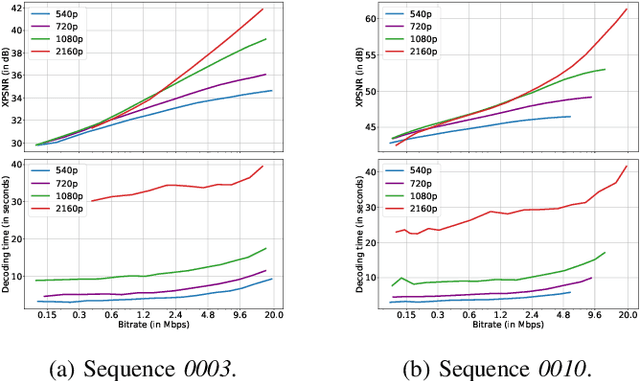
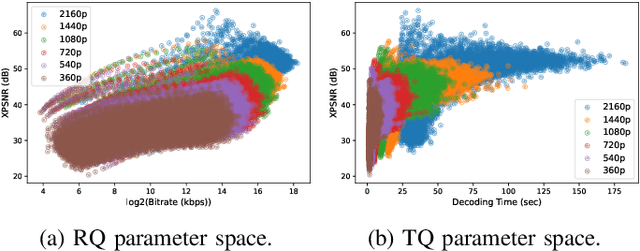
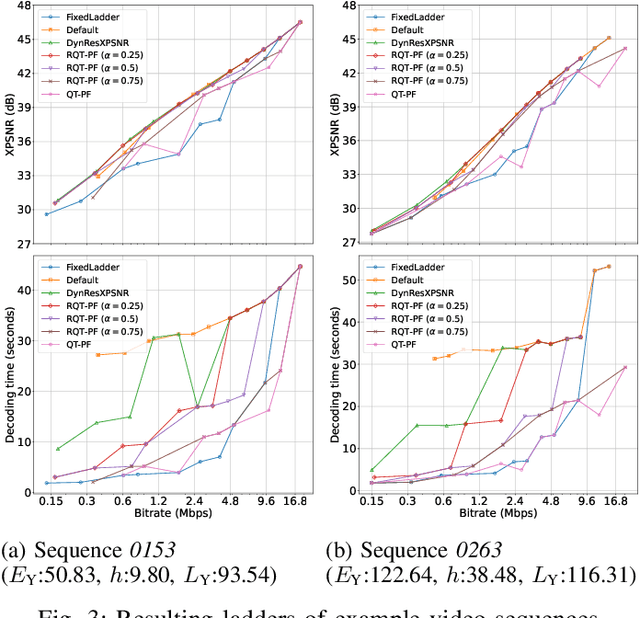
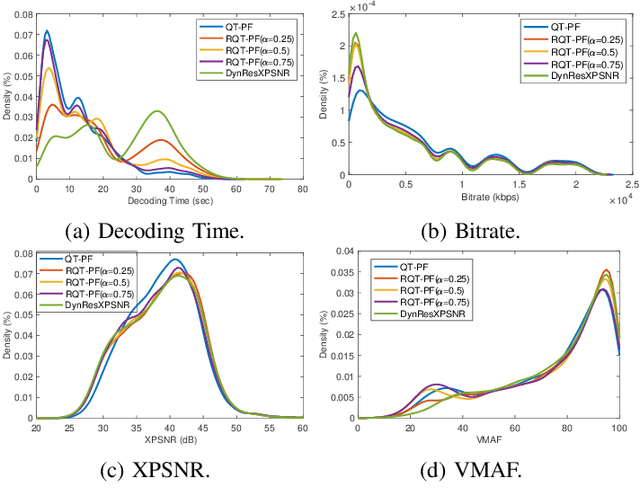
Abstract:Pareto-front optimization is crucial for addressing the multi-objective challenges in video streaming, enabling the identification of optimal trade-offs between conflicting goals such as bitrate, video quality, and decoding complexity. This paper explores the construction of efficient bitrate ladders for adaptive Versatile Video Coding (VVC) streaming, focusing on optimizing these trade-offs. We investigate various ladder construction methods based on Pareto-front optimization, including exhaustive Rate-Quality and fixed ladder approaches. We propose a joint decoding time-rate-quality Pareto-front, providing a comprehensive framework to balance bitrate, decoding time, and video quality in video streaming. This allows streaming services to tailor their encoding strategies to meet specific requirements, prioritizing low decoding latency, bandwidth efficiency, or a balanced approach, thus enhancing the overall user experience. The experimental results confirm and demonstrate these opportunities for navigating the decoding time-rate-quality space to support various use cases. For example, when prioritizing low decoding latency, the proposed method achieves decoding time reduction of 14.86% while providing Bjontegaard delta rate savings of 4.65% and 0.32dB improvement in the eXtended Peak Signal-to-Noise Ratio (XPSNR)-Rate domain over the traditional fixed ladder solution.
ReLaX-VQA: Residual Fragment and Layer Stack Extraction for Enhancing Video Quality Assessment
Jul 16, 2024
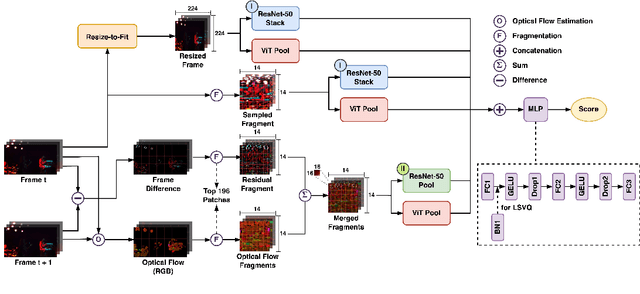

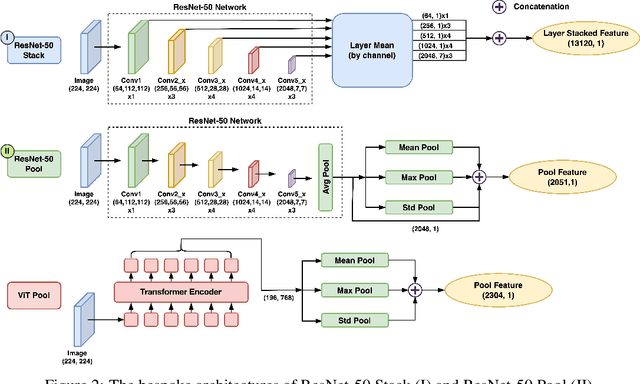
Abstract:With the rapid growth of User-Generated Content (UGC) exchanged between users and sharing platforms, the need for video quality assessment in the wild has emerged. UGC is mostly acquired using consumer devices and undergoes multiple rounds of compression or transcoding before reaching the end user. Therefore, traditional quality metrics that require the original content as a reference cannot be used. In this paper, we propose ReLaX-VQA, a novel No-Reference Video Quality Assessment (NR-VQA) model that aims to address the challenges of evaluating the diversity of video content and the assessment of its quality without reference videos. ReLaX-VQA uses fragments of residual frames and optical flow, along with different expressions of spatial features of the sampled frames, to enhance motion and spatial perception. Furthermore, the model enhances abstraction by employing layer-stacking techniques in deep neural network features (from Residual Networks and Vision Transformers). Extensive testing on four UGC datasets confirms that ReLaX-VQA outperforms existing NR-VQA methods with an average SRCC value of 0.8658 and PLCC value of 0.8872. We will open source the code and trained models to facilitate further research and applications of NR-VQA: https://github.com/xinyiW915/ReLaX-VQA.
Rate-Quality or Energy-Quality Pareto Fronts for Adaptive Video Streaming?
Feb 10, 2024Abstract:Adaptive video streaming is a key enabler for optimising the delivery of offline encoded video content. The research focus to date has been on optimisation, based solely on rate-quality curves. This paper adds an additional dimension, the energy expenditure, and explores construction of bitrate ladders based on decoding energy-quality curves rather than the conventional rate-quality curves. Pareto fronts are extracted from the rate-quality and energy-quality spaces to select optimal points. Bitrate ladders are constructed from these points using conventional rate-based rules together with a novel quality-based approach. Evaluation on a subset of YouTube-UGC videos encoded with x.265 shows that the energy-quality ladders reduce energy requirements by 28-31% on average at the cost of slightly higher bitrates. The results indicate that optimising based on energy-quality curves rather than rate-quality curves and using quality levels to create the rungs could potentially improve energy efficiency for a comparable quality of experience.
Comparative Study of Hardware and Software Power Measurements in Video Compression
Dec 19, 2023Abstract:The environmental impact of video streaming services has been discussed as part of the strategies towards sustainable information and communication technologies. A first step towards that is the energy profiling and assessment of energy consumption of existing video technologies. This paper presents a comprehensive study of power measurement techniques in video compression, comparing the use of hardware and software power meters. An experimental methodology to ensure reliability of measurements is introduced. Key findings demonstrate the high correlation of hardware and software based energy measurements for two video codecs across different spatial and temporal resolutions at a lower computational overhead.
UGC Quality Assessment: Exploring the Impact of Saliency in Deep Feature-Based Quality Assessment
Aug 13, 2023Abstract:The volume of User Generated Content (UGC) has increased in recent years. The challenge with this type of content is assessing its quality. So far, the state-of-the-art metrics are not exhibiting a very high correlation with perceptual quality. In this paper, we explore state-of-the-art metrics that extract/combine natural scene statistics and deep neural network features. We experiment with these by introducing saliency maps to improve perceptibility. We train and test our models using public datasets, namely, YouTube-UGC and KoNViD-1k. Preliminary results indicate that high correlations are achieved by using only deep features while adding saliency is not always boosting the performance. Our results and code will be made publicly available to serve as a benchmark for the research community and can be found on our project page: https://github.com/xinyiW915/SPIE-2023-Supplementary.
Subjective assessment of the impact of a content adaptive optimiser for compressing 4K HDR content with AV1
Jun 26, 2023



Abstract:Since 2015 video dimensionality has expanded to higher spatial and temporal resolutions and a wider colour gamut. This High Dynamic Range (HDR) content has gained traction in the consumer space as it delivers an enhanced quality of experience. At the same time, the complexity of codecs is growing. This has driven the development of tools for content-adaptive optimisation that achieve optimal rate-distortion performance for HDR video at 4K resolution. While improvements of just a few percentage points in BD-Rate (1-5\%) are significant for the streaming media industry, the impact on subjective quality has been less studied especially for HDR/AV1. In this paper, we conduct a subjective quality assessment (42 subjects) of 4K HDR content with a per-clip optimisation strategy. We correlate these subjective scores with existing popular objective metrics used in standard development and show that some perceptual metrics correlate surprisingly well even though they are not tuned for HDR. We find that the DSQCS protocol is too insensitive to categorically compare the methods but the data allows us to make recommendations about the use of experts vs non-experts in HDR studies, and explain the subjective impact of film grain in HDR content under compression.
Recommendations for Verifying HDR Subjective Testing Workflows
May 19, 2023
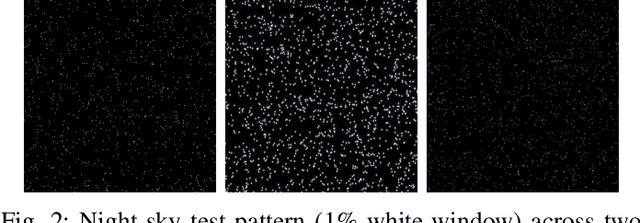
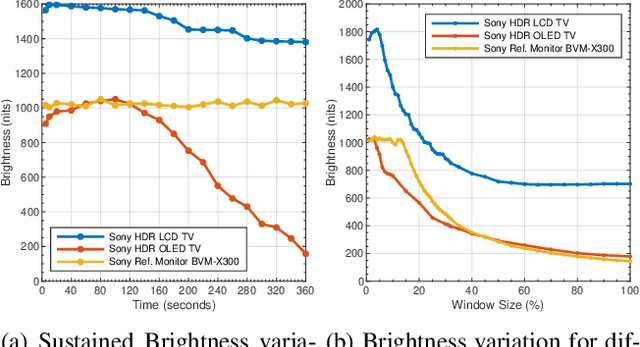
Abstract:Over the past few years, there has been an increase in the demand and availability of High Dynamic Range (HDR) displays and content. To ensure the production of high-quality materials, human evaluation is required. However, ascertaining whether the full playback pipeline is indeed HDR-compliant can be challenging. In this paper, we present a set of recommendations for conformance testing to validate various aspects of the testing workflow, including playback, displays, brightness, colours, and viewing environment. We assessed the effectiveness of HDR conversion techniques used in current standards development (3GPP) for making source materials. Additionally, we evaluate HDR display technologies, including OLED and LCD, using both consumer television and a reference monitor.
Comparison of HDR quality metrics in Per-Clip Lagrangian multiplier optimisation with AV1
Mar 28, 2023

Abstract:The complexity of modern codecs along with the increased need of delivering high-quality videos at low bitrates has reinforced the idea of a per-clip tailoring of parameters for optimised rate-distortion performance. While the objective quality metrics used for Standard Dynamic Range (SDR) videos have been well studied, the transitioning of consumer displays to support High Dynamic Range (HDR) videos, poses a new challenge to rate-distortion optimisation. In this paper, we review the popular HDR metrics DeltaE100 (DE100), PSNRL100, wPSNR, and HDR-VQM. We measure the impact of employing these metrics in per-clip direct search optimisation of the rate-distortion Lagrange multiplier in AV1. We report, on 35 HDR videos, average Bjontegaard Delta Rate (BD-Rate) gains of 4.675%, 2.226%, and 7.253% in terms of DE100, PSNRL100, and HDR-VQM. We also show that the inclusion of chroma in the quality metrics has a significant impact on optimisation, which can only be partially addressed by the use of chroma offsets.
Energy-Rate-Quality Tradeoffs of State-of-the-Art Video Codecs
Oct 02, 2022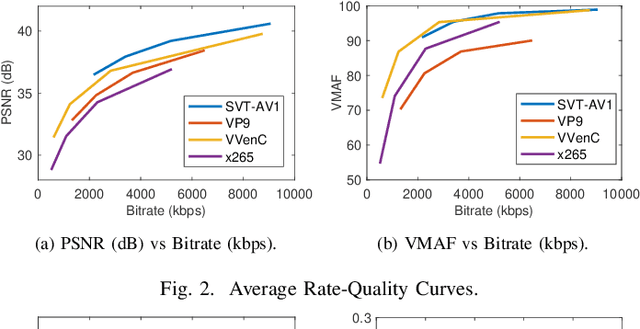
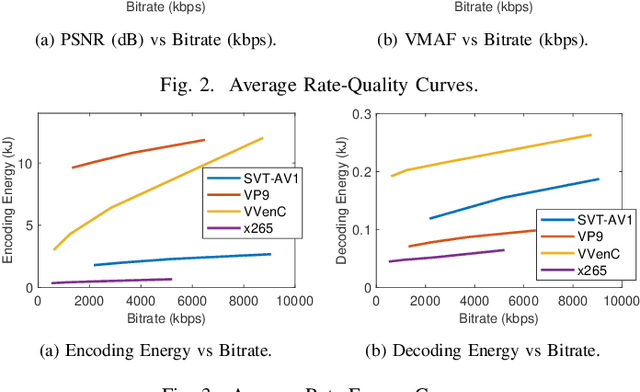
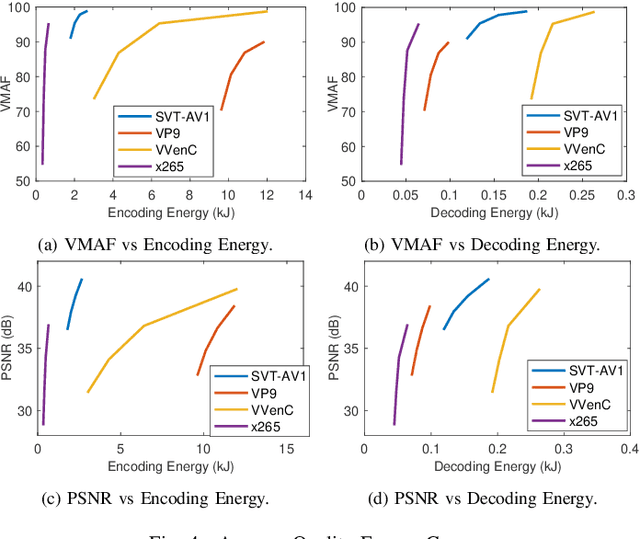
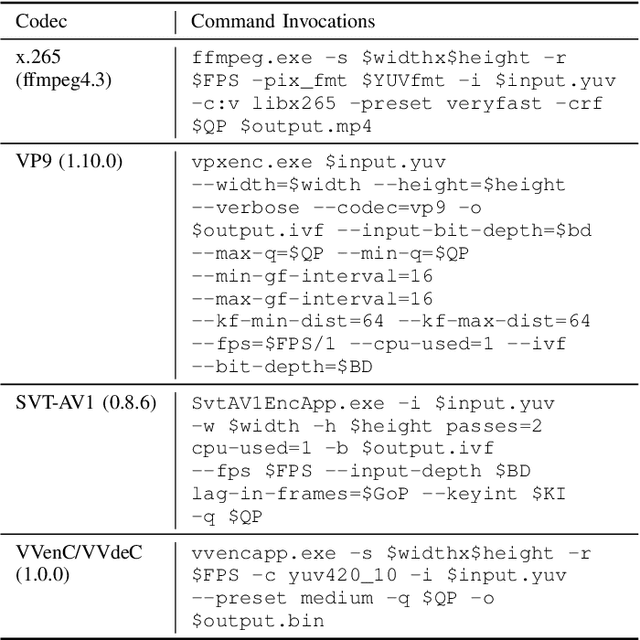
Abstract:The adoption of video conferencing and video communication services, accelerated by COVID-19, has driven a rapid increase in video data traffic. The demand for higher resolutions and quality, the need for immersive video formats, and the newest, more complex video codecs increase the energy consumption in data centers and display devices. In this paper, we explore and compare the energy consumption across optimized state-of-the-art video codecs, SVT-AV1, VVenC/VVdeC, VP9, and x.265. Furthermore, we align the energy usage with various objective quality metrics and the compression performance for a set of video sequences across different resolutions. The results indicate that from the tested codecs and configurations, SVT-AV1 provides the best tradeoff between energy consumption and quality. The reported results aim to serve as a guide towards sustainable video streaming while not compromising the quality of experience of the end user.
 Add to Chrome
Add to Chrome Add to Firefox
Add to Firefox Add to Edge
Add to Edge